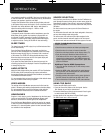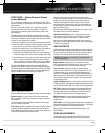
37
ADVANCED FUNCTIONS
ENGLISH
unable to run EzSet/EQ calibration, or if you wish to make further
adjustments, use the Manual Speaker Setup on-screen menus.
Before beginning, place your loudspeakers as explained in the
Speaker Placement section, and connect them to the AVR. Consult
the owner’s guide for the speakers or the manufacturer’s Web site
for the frequency range specification. Although you may set the out-
put levels “by ear,” an SPL (sound-pressure level) meter purchased
at a local electronics store will provide greater accuracy.
Record your configuration settings in Tables A3 through A12 in the
appendix for easy re-entry after a system reset, or if the AVR’s
Master Power Switch is turned off or the unit is unplugged for
more than four weeks.
NOTE: When using the AVR’s Speaker Setup menus, select
a video output resolution of 720p or higher to view graphics
that simplify configuration.
STEP ONE – Determine Speaker
Crossover
Without using the EzSet/EQ process, the AVR 2600 can’t detect
how many speakers you’ve connected to it; nor can it determine
their capabilities. Consult the speaker’s technical specifications
and locate the frequency response, usually given as a range, e.g.,
100Hz – 20kHz (±3dB). Write down the lowest frequency that each
of your main speakers is capable of playing (100Hz in the example)
as the crossover in Table A3 in the appendix. This is not the same
as the crossover frequency listed in the speaker’s specifications.
For the subwoofer, write down the transducer size.
The receiver’s bass management determines which speakers will
be used to play back the low-frequency (bass) portion of the source
program. Sending the lowest notes to small satellite speakers won’t
sound right, and may even damage the speaker. The highest notes
may not be heard at all through the subwoofer.
With proper bass management, the AVR 2600 divides the source
signal at a crossover point. All information above the crossover
point is played through the satellite speaker, and all information
below the crossover point is played through the subwoofer. Each
loudspeaker in your system performs at its best, delivering an
enjoyable sound experience.
STEP TWO – Measure Speaker Distances
Ideally, all of your speakers would be placed in a circle, with the
listening position at the center. However, you may have had to place
some speakers a little further away from the listening position than
others. Sounds that are supposed to arrive simultaneously from
different speakers may blur, due to different arrival times.
Use the AVR’s delay adjustment to compensate for real-world
speaker placements.
Measure the distance from each speaker to the listening position,
and write it down in Table A4 in the appendix. Even if all of your
speakers are the same distance from the listening position, enter
your speaker distances as described in Step Three.
STEP THREE – Manual Setup Menu
Now you are ready to program the receiver. Sit in the usual listening
position and make the room as quiet as possible.
With the receiver and video display turned on, press the Setup
Button to display the menu system. Use the 5 Button to move the
cursor to the Speaker Setup line, and press the OK Button to display
the Speaker Setup menu. See Figure 21.
If you have run the EzSet/EQ process, the results were saved. To
tweak the EzSet/EQ results, or to configure the AVR 2600 from
scratch, select Manual Setup. A screen similar to the one shown
in Figure 31 will appear.
Figure 31 – Manual Speaker Setup Menu
NOTE: All of the speaker setup submenus include the Back
option, as shown at the bottom of Figure 31. To save the current
settings, select the Back option.
To reconfigure the speakers from scratch, select the Reset option.
For best results, adjust the submenus in this order: Number of
Speakers, Crossover (Size), Sub Mode, Distance and Level Adjust.
Number of Speakers
Move the cursor to the Number of Speakers line and press the
OK Button. See Figure 32.
Figure 32 – Number of Speakers Menu
Program the correct setting for each speaker group: ON when the
speakers are present in the system, and OFF for positions where no
speakers are installed. The Front Left & Right speakers are always
ON and may not be disabled. Any changes will be reflected in the
total number of speakers displayed at the top of the screen.
The setting for the surround back speakers includes a third option:
Zone 2. The AVR 2600 is capable of multizone operation, supporting
placement of a pair of speakers in another room. The AVR 2600’s
assignable surround back amplifier channels make multizone operation
easier than ever, since an external power amplifier is not required.
Select the Zone 2 option at this line, and connect the Surround
Back Speaker Outputs to loudspeakers located in the remote room.
0142CSK - HK AVR 2600 OM Inlay_ENG_v2.qxp:HKP1477AVR245om.v2.qxd 26/05/09 10:36 Side 37


















